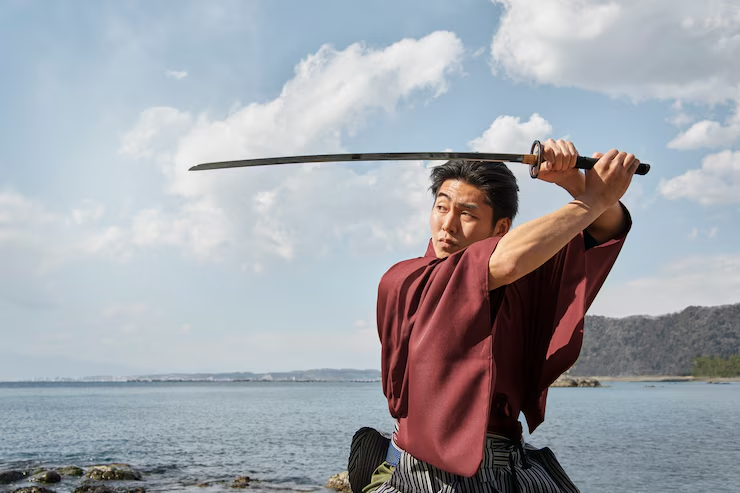Two countries have produced iconic swords that have captured many years of history and art. But what truly is the secret to Chinese and Japanese swords?
This question sets the stage for a grueling debate among collectors and historians. This article will probe the complexities surrounding the Chinese and Japanese swords debate. We will explore their histories and what makes them unique to help you decide which is better.
Japanese Swords
The katana is a Japanese-renowned sword. With its iconic curved blade, it has a rich history spanning centuries. From the 10th century, the weapon evolved alongside the samurai status. It became a sword of war and a mark of honor. Samurai viewed their swords as part of themselves. They used the swords in battle and practiced with mystical precision. The katana symbolizes “bushido,” the samurai standard of honor. Even today, the Japanese culture reveres the katana, representing Japan’s spirit and heritage.
Chinese Swords
Chinese weapons are as diverse as the country’s long history. The Jian, which dates back over 2,500 years, symbolizes wisdom and nobility. The dao, with single-edged and curved blades, became popular. It was celebrated for its versatility in military and civilian settings. Chinese swords have a deep cultural meaning. They’re linked to philosophies like Confucianism and Taoism, used by scholars, warriors, and monks. The weapons represent mastery and balance in body and mind.
Comparing Cultural Impact
While Japanese swords are more specialized, particularly associated with the samurai, Chinese swords represent broader versatility, having evolved for various societal roles. Both carry deep symbolism and are treasured as national icons, yet each reflects different philosophies and cultural values.
Structural and Technical Differences
Culture, climate, and combat needs contribute to the structure of Japanese katana and Chinese swords. The variances affect the weapons’ performance. Here are the key differences:
Blade Shape and Design
Japanese and Chinese swords look distinct at first glance. The katana is curved and single-edged, allowing for a sharp, slicing motion. It’s often recognized for its sleek shape and precision. In contrast, the jian features a straight, double-edged blade that is best for thrusting, slicing, and thrusting. The dao’s slight curve is suited for quick, slashing attacks. This design makes Chinese swords have a broader range of uses. Each shape is customized to specific combat needs.
Materials and Swordsmithing Techniques
Japanese artisans use a specific folding skill to create tamahagane. This process involves continuously hammering, heating, and folding the steel, which helps to remove impurities and enhance durability. The result is a powerful, sharp blade with a distinctive wave-like pattern. Chinese weapons also benefit from specialized metalworking techniques but are typically less keen on folding steel. Chinese swordsmiths adopted skills from neighboring regions, leading to many blades that balanced flexibility and strength.
Edge and Sharpness
The katana is well known for its sharpness and edge retention. This is achieved through a specialized tempering process. The result is a hardened edge that keeps the spine softer for shock absorption. Chinese swords also focus on versatility over intense sharpness, with blades created for different techniques.
Handle and Grip Style
Japanese swords have a more extended handle. It’s built for a two-handed grip, providing better handling and power for cutting motions. However, Chinese swords tend to have shorter grips, allowing for more one-handed use and flexibility. This difference explains each sword’s unique combat style, with the katana emphasizing balanced power and Chinese swords designed for fast changes in direction.
Combat Techniques and Use Cases
Japanese and Chinese swords have a long history of martial traditions. Each country has unique combat techniques. Here’s the breakdown:
Japanese Swords
Japanese swords are suited for close-quarters combat and focus on powerful, precise cuts. Martial arts such as Iaido, Kendo, and Kenjutsu center around the katana, emphasizing discipline, technique, and a one-strike approach. Practitioners train rigorously to master smooth, controlled cuts where the curved blade’s design shines. The katana’s edge can deliver devastating results in duels and one-on-one confrontations.
Chinese Swords
Chinese swords, such as those used in kung fu and tai chi, are used in martial arts events. The Jian allows for offensive and defensive techniques, which involve quick movements that consist of thrusts and cuts. The Dao is preferred for fast, sweeping motions, making it highly effective in multiple-opponent scenarios. Chinese martial arts emphasize adaptability and strategic movement, allowing practitioners to use the sword effectively.
Situational Effectiveness
The katana’s efficient, powerful stabs are highly effective in one-on-one combat. However, where versatility is required, like on battlefields with many opponents, the adaptability of Chinese swords prevails. Each sword has an upper hand in specific combat scenarios. The choice depends mainly on the combat style and situation.
Pros and Cons of Japanese and Chinese Swords
Each type of sword from either country has specific strengths and drawbacks.
Pros of Japanese Swords (Katana)
- Exceptional craftsmanship with intense edge sharpness.
- Known for precise, controlled cutting power.
- It’s deeply symbolic and has high cultural value in Japanese martial arts.
Cons of Japanese Swords
- Limited versatility, primarily designed for single combat.
- Requires specialized maintenance and care due to its delicate edge.
- Generally more expensive due to intricate craftsmanship.
Pros of Chinese Swords (Jian and Dao)
- Versatile and adaptable for various fighting styles and combat situations.
- Wide range of designs tailored for different applications.
- It is more accessible to use for beginners and more affordable for collectors.
Cons of Chinese Swords
- Typically less sharp than a katana, focusing on flexibility over sharpness.
- Less focused on a single purpose, which may appeal less to collectors of specialized items.
Practical Considerations for Modern Martial Artists and Collectors
Sword enthusiasts often have different priorities when dealing with weapons from different countries. Here’s what to consider when practicing Japanese and Chinese swords.
Martial Artists’ Perspective
The choice of martial artists is based on discipline. The katana may be better suited for those interested in traditional Japanese arts like laido or Kendo. Meanwhile, Chinese sword styles like Tai Chi and Wushu offer a more holistic approach. They make the swords more appealing, especially to practitioners who desire flexibility in their moves.
Collectors’ Perspective
Collectors often consider historical value and craftsmanship. With its intricate forging and cultural significance, the Makoto Katana is a prized item among collectors, yet it comes with high maintenance requirements. Chinese swords are often valued for their unique designs and accessibility. Each sword provides a rare glimpse into the traditions and histories of China and Japan.
Conclusion
The choice of which sword is better depends on personal preference and purpose. The Japanese katana focuses on sharpness, precision, and revered status. The Chinese jian and dao are versatile and integral to a broader range of martial traditions. Both are remarkable in their own right—whether for their historical importance, technical craftsmanship, or practical use in martial arts. Instead of choosing a definitive winner, it’s better to appreciate what each brings to the table, reflecting their respective lands’ unique cultural values and philosophies.











